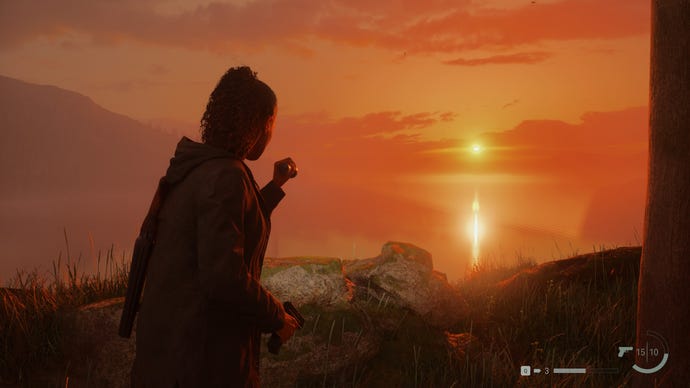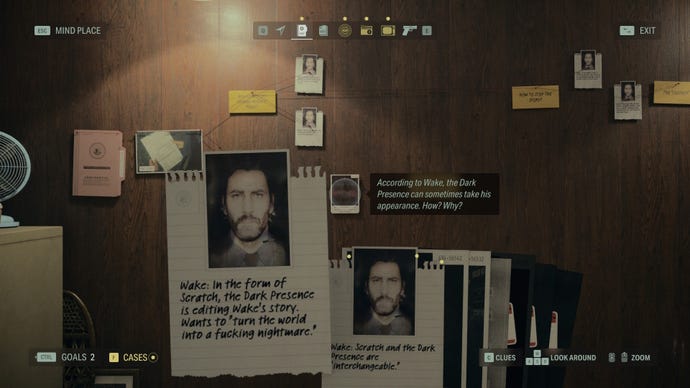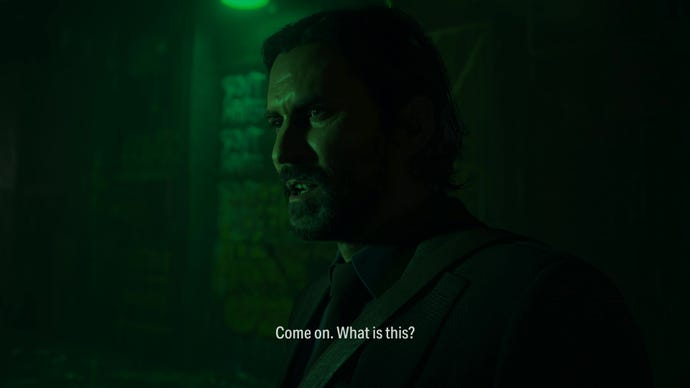It is perhaps ironic that in attempting to crystalise my thoughts about Alan Wake 2 – a game about a novelist with such crippling writer’s block that they end up spawning an entire evil doppelganger of themselves to sabotage their own work – I, too, have been hopelessly staring at a blank screen for the better part of 24 hours. I have not, thank goodness, reached the stage where my psyche’s split in two (yet), but this spiral of self-doubt has now got to the point where I simply have put words, any words, in front of one another to write my way out of this hellish pit of despair.
Alan himself goes through a similar ordeal of writing to escape as he tries to find a way out of the prison-like dimension known as The Dark Place, where he’s been trapped since the events of the first game – and I take heart from the fact that it’s clearly well-worn territory for the folks at Remedy as well, such is the forensic precision in the way it’s portrayed onscreen: a chaotic, supernatural tornado that not only threatens to unravel Alan’s own identity, but also the wider world as we know it. It’s imposter syndrome writ large, and honestly, Remedy are pretty on the money with this one. Horace is not a pretty taskmaster when the words stop coming.

As hinted at last week, Alan Wake 2 is a much more visceral and, well, horrifying kind of horror game than what Remedy have made before. It is still fundamentally about a man – and now also a woman in the form of FBI agent and fellow deuteragonist Saga Anderson – pointing a torch at some ghosts to bring them kicking and screaming into the real world so you can kill them a second time with a variety of pistols, shotguns, rifles and crossbows until they evaporate in an oily smudge of ectoplasmic wind. But the drama, tension and stylistic presentation of these encounters weighs much more heavily on your nerves this time around.
For starters, it deliberately takes its time building up its atmosphere, holding back any kind of action until almost two hours in. Yet it doesn’t feel slow in the slightest, as you’re immediately thrown into the thick of Saga’s investigation work as she gathers evidence pertaining to a ritualistic murder cult that’s taken root in the Twin Peaksian town of Bright Falls – the same location where Alan Wake 1 took place. Saga is a refreshingly grounded presence in Alan Wake 2, helping to anchor the game in a way that simply wasn’t possible first time round when all we had was Alan’s motor-mouth narration detailing his every move. Her approach to detective work is equally relaxed and methodical, achieved mostly by interacting with objects and parts of the environment, though talking to people will also reveal important clues, as will using Saga’s special Profile ability to make creative leaps in her lines of enquiry. These information nuggets are then assembled in her Sherlock Holmes-esque mind palace, where you match clues to questions posed on a big pin board at the back of the room.



I wrote in my earlier impressions that there isn’t really that much deduction work to be done here, and this holds true now that I’ve finished it. Every clue has its own set place on the board, for example, and most of the time it’s obvious where they’re all meant to slot into place (and if all else fails, you can just brute force it until it’s right). Clues gathered prior to their respective question appearing on the board will also have a ‘For Later’ sticker applied to them so you’re not endlessly trying to shove a square into a round hole, but evidence in some of the additional ‘background’ cases can also be missed if you’re not thorough. Then again, leaving these unsolved didn’t seem to matter much when I reached the conclusion. A shame, really, especially as one of Saga’s late-game lines did seem to imply that ‘supporting evidence’ would be critical to her and Alan’s success.

While Alan Wake 2 can be enjoyed on its own terms, having a working knowledge of what happened in the original game (either by playing it or watching a recap video) is strongly recommended. It will help you understand more of its references and wider goings on in the game, and you’ll get a lot more out of it. Control you can easily skip, though, as these references are much more surface level. All you need to know is that there’s a thing called the Federal Bureau of Control that operates separately to the FBI, and that’s about it. Oh, and it has a weird Janitor chap called Ahti as well.
Image credit: Fr.TechTribune.net/Epic Games Publishing
But while evidence gathering forms the backbone of Saga’s progression through the game, the player sadly isn’t trusted with any of the actual problem solving. Instead, Saga will simply announce her conclusions in a couple of lines of exposition once you’ve assembled all the right pieces, leaving the player to simply accept and absorb the answer on autopilot. Sure, there’s nothing wrong with this approach, but it also feels like Remedy want to have their cake and eat it slightly, making you feel like you’re playing an episode of True Detective, but robbing you of the thrill of being an active participant. (Though I will say there’s a particularly subversive moment right toward the end of the game that really turns its automated problem solving on its head, but it’s all a little too late to really have much of an impact).
Still, while Alan Wake 2’s detective work feels a little bit like a first draft, the rest of it feels significantly more confident and assured in what it’s trying to achieve. When Saga and Alan do finally get their hands on a gun, each combat encounter feels tense and significant, partly because there are fewer of them to begin with. Enemies hit hard and fast, and careful crowd control with its equally sparing number of torch batteries and ammo packs is key to your survival. The safety nets of its streetlamps are equally sparse, too, and its foreboding musical score ensures you always feel uneasy even when the coast is clear. It all works to make Alan Wake 2 feel much more in keeping with the likes of earlier Resident Evil games, as do the smattering of little note-based logic puzzles you’ll encounter that unlock new weapons and item stashes hidden around the world. Admittedly, the combat never really evolves a huge amount over the course of the game – a step down from the wild powers we saw in Control, perhaps – but the fact it’s able to maintain such a palpable sense of dread and tension across 25-30 hours without letting up is a testament to Remedy’s expertly judged sense of pacing.
Alan’s sections are even more nerve-shredding, too. Since the Dark Place is pretty much ghost central compared to the real world, you’ll see dozens upon dozens of them milling about in the open, all aggressively growling « WAKE » as soon as they clap eyes on you. Not all of them are hostile, though, and sussing out the good from the bad makes approaching an enemy a nervous game of sizing up your opponent, waiting for the moment they’ll fade from view as you stare them down with your torch. You’re constantly waiting for that telltale flicker of a slasher teleporting to your flank, or the flash of a crowbar, axe or wrench appearing in their twitchy, hungry palms, and the catharsis of guessing correctly immediately makes up for all the other times you’re taken by surprise.


His segments are also much more successful at blending the real with the imaginary, transposing glimpses of live action footage on top of the game world to really hammer home the idea of its interlocking dimensions, and the Dark Place’s looping, chameleon-like dream logic. Alan’s progress, for example, comes from landing on new ideas for scenes in the story he’s trying to write. When these are applied to pre-defined areas in his environment via his version of Saga’s mind palace – the writer’s room – the scenery in front of you twists and morphs into a new version of itself, opening up new pathways in the process. It’s sumptuously presented, with exquisite use of light, eye-catching colours and horrifying imagery to make every interpretation feel unique and unsettling. Similarly, seeing Alan’s live-action hands tap away at his typewriter as the scene clicks and slides into place underneath until they’re finally revealed in a snap of light is a particularly neat visual flourish that never gets old. This weaving of different mediums not only solidifies Remedy’s place as one of today’s great technical masters, but also what is surely one of the most singular and richly realised creative visions of a place I’ve ever seen in a video game.
In fairness, Alan’s sections also make extensive use of live action sequences that are just straight up cutscenes a lot of the time, too, with some moments verging on almost Hideo Kojima levels of self-indulgence. There is, I kid you not, an entire 15-minute short film in here if you fancy it, starring not only Alan Wake 2’s very own co-director and co-lead writer Sam Lake, but also every other actor who lends their voice and face to characters elsewhere in the game. The whole thing is too knotty and daft to go into, but to say this game is self-referential and meta in the extreme doesn’t even begin to cover it.

This is ultimately what sets Alan Wake 2 apart from the rest of the horror genre, and why, despite its flaws, it continues to feel so singular and unique. The sense of place it creates with its bold use of different mediums is truly outstanding, and visually it’s in a class all on its own. It is at once horrific, absurd, surreal, tragic and genuinely scary, and the sheer weirdness of it all permeates every fibre of its being. It is not just a game about a man with terrible writer’s block whose world may or may not be collapsing around him in real time. It is also about some very real fears we live with now, such as the horror of misinformation and the gaslighting effect of fiction overtaking fact, where lives and identities can be rewritten in an instant. The Dark Place lets all of these ideas run wild to their most terrifying extremes, but Saga’s fight to reclaim her story against these overwhelming odds makes for a highly compelling counterpoint to Alan’s mania.

Until, sadly, it doesn’t. Whether Remedy are saving their true conclusion for the already announced DLC expansions or simply treading water until what feels like the inevitable Alan Wake 3, the climax to Saga and Alan’s story does drop the ball somewhat in its very final moments. Enough is resolved to not feel like it’s a complete disappointment, but it also leaves just enough hanging in the air to feel faintly unsatisfying at the same time. « This is not the ending I wanted, » Alan Wake says himself at the start of the game, and yes, too right mate. Still, even if Remedy’s spellbinding undertaking does eventually come undone at the final hurdle, it remains a horror game unlike any other. Here’s hoping Remedy don’t suffer their own bout of writer’s block as they continue their journey into their burgeoning Connected Universe.
This review was based on a review build of the game provided by developers Remedy Entertainment.










